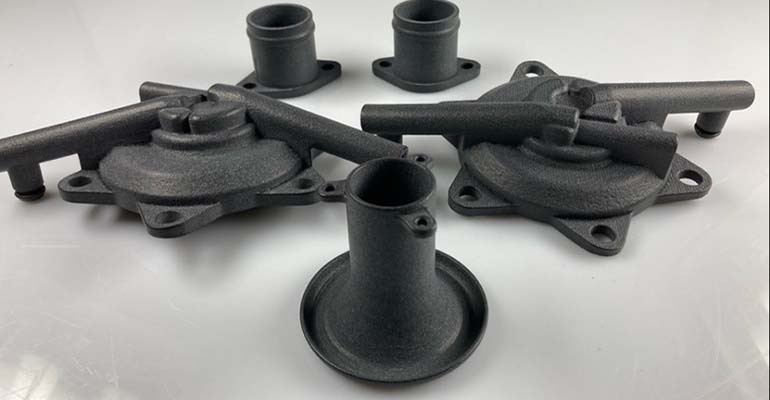Fiber-reinforced Polyamide for 3D Printing Boasts Low Moisture Absorption
Compounder Lehvoss partners with Evonik to develop compound that also addresses safety concerns involving carbon microfibers.
December 4, 2023

At a Glance
- A safer option versus carbon fiber/dry powder mixes for operators
- Already approved by automotive OEMs
- Evonik also unveils PA 12 powder for industrial 3D printing that uses 100% bio-circular feedstock
Industrial 3D printing requires plastic materials that, as printed components, ideally correspond to the performance level of injection-molded parts. This is key to finding applications for special components or in the spare parts market without a major qualification effort or design adjustment. The standard materials in the plastics industry for 3D printing primarily include 10% and 30% glass-fiber-reinforced polypropylene (PP GF10, PP GF30) and a similarly reinforced polyamide 6 (PA6 GF30).
Powder bed printing processes such as laser sintering offer almost unlimited geometric freedom when printing components, which is necessary because the components originally designed for injection molding have complex geometries.
Unfortunately, reinforced polymers in powder form can represent a safety risk. You can make do with fibers mixed dry into plastic powders. However, unbound, very thin fibers or microscopically thin needles are risky to handle from an occupational safety perspective and for this reason normally do not receive internal approval from industrial 3D-printing processors.
Addressing the danger of microfibers
In cooperation with Evonik, compounding company Lehvoss has now developed a PA613 with compounded carbon-fiber reinforcement. The base PA613 polymer was designed by Evonik specifically for laser sintering. As such, it is characterized by low moisture absorption, high temperature stability, and – unlike PA6 – high process stability in laser sintering. The fiber reinforcement consists of high-strength XCF (extra carbon fiber), which has been used previously in Luvocom XCF products for injection molding. When it comes to powder production, new approaches to particle technology were taken in order to preserve the fiber lengths in the individual particles as best as possible.
Printing with Luvosint PA613 9711 CF requires a build chamber temperature of 195°C, which means standard laser sintering machines are suitable for processing. The material absorbs the wavelengths of CO2, diode, or fiber lasers. “The fact that the first automotive OEMs have already qualified [our material] for spare-part production shows that we are on the right track,” said Marcus Rechberger, product manager for Luvosint at Lehvoss Group. “Nevertheless, in laser sintering, there still needs to be a lot of willingness to innovate in order to develop even more industrially relevant materials — including machines optimized for this — in order to bring industrial 3D printing into series production," said Rechberger.
Circular 3D printing
Evonik has introduced a new grade of its PA 12 powders that is designed to unbound sustainable 3D printing at scale. Infinam eCO PA12 is the world’s first PA 12 powder material for industrial 3D printing that substitutes 100% of fossil feedstock with bio-circular raw material from waste cooking oil in a mass balance process. The new, ready-to-use powder features a reduction in CO2 emissions of 74% in comparison to the company’s Infinam Terra development grade partially based on castor oil that was introduced in late 2022.
Besides an improved carbon footprint rate due to renewable energy use for production and its use of bio-based raw material, Evonik’s new PA 12 grade enables a 100% reusability rate of the structure-support powder, with a refresh rate of 70/30 of used versus virgin material over several printing cycles. The printed parts reportedly exhibit excellent processability and stable mechanical properties.
“True circularity is key for being successful in the future. As a pioneer for polymer-based 3D-printing materials, Evonik has developed a formula for its PA12 powders to drive a circular plastics economy in additive manufacturing,” said Evonik’s Dominic Störkle.
About the Author(s)
You May Also Like




